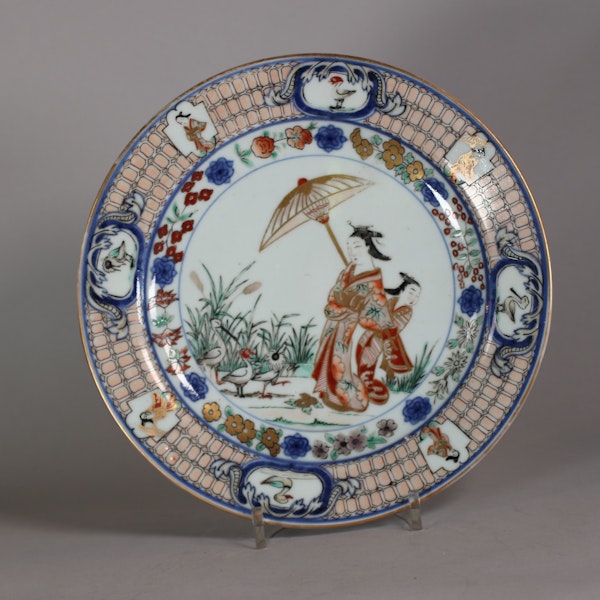Japanese Pronk ‘Dame au Parasol’ plate, 1736-1740
Japanese Pronk ‘Dame au Parasol’ plate, 1736-1740
POA
Description
Japanese Pronk ‘Dame au Parasol’ plate, 1736-1740, decorated in the Imari palette with underglaze cobalt blue, polychrome enamels and gilt to the central well with an oiran wearing a richly embroidered kimono, an obi tied to the front and kanzashi hair ornaments, strolling in a garden landscape with a young kamuro in attendance holding a parasol, reeds and three strutting waterfowl; encircled by a band of floral sprays and circles of underglaze blue, the wide rim with four shaped cartouches containing waterfowl alternating with smaller vignettes of oiran in a garden, against a pink cellular ground, the reverse with seven flying insects in iron-red enamel.
Notes:
In 1734 the VOC, hoping to capitalise on the popularity of ‘Chine de Command’ porcelain amongst a wealthy European consumer base, commissioned an established topographical draughtsman, Cornelius Pronk, to provide designs to be recreated by Asian potters on wares for export. These watercolour designs, two of which can be found in the collection of the Rijksmuseum (RP-T-1967-18), were sent to the VOC headquarters in Batavia and then on to Canton in 1736. One of the designs, known as ‘La Dame au Parasol’, was also sent to Japan as an experiment by the VOC, to explore the possibility of manufacturing a Japanese version of the design. In his 1959 study, Volker includes an excerpt of a message sent with the watercolour: ‘We are pleased that your Honours have had the drawings of porcelains sent from this country presented to the Japanese factors in order to test out whether the same can be made in Japan conforming with the drawings’ However, production in Japan proved costly for the VOC and the experiment was abandoned in 1740, though it is highly likely that private trade by supercargoes continued for a time after.
Though these Japanese Pronk plates were only produced for a very short period of time and thus are rather rare, similar plates can be found in several prominent collections worldwide, including those of the Metropolitan Museum of Art (2002.447.121), the Minneapolis Institute of Art (2015.79.301), the Ashmolean Museum (EA1978.489) and the Museum of Oriental Ceramics, Osaka.
For further reading, similar examples and discussion of Pronk porcelain in Japan and China see:
T. Volker, The Japanese Porcelain Trade of the Dutch East India Company after 1683, (Leiden, 1959), pp. 78-81.
Soame Jenyns, Japanese Porcelain, (London, 1965), pl. 46A.
Christiaan J.A. Jörg, Pronk Porcelain: Porcelain after Designs by Cornelis Pronk (Groningen: Groninger Museum, 1980) pp. 71-3.
William R. Sargant, 'Cornelis Pronk and His Influence', in Treasures of Chinese Export Ceramics from the Peabody Essex Museum (New Haven: Yale University Press, 2012), pp. 275-279.
Ayers, Impey & Mallet, Porcelain for Palaces, The fashion for Japan in Europe 1650 -1750 (London: OCS, 1990) page 114, plate 70.
| item details | |
|---|---|
| Material and Technique | Porcelain with underglaze cobalt blue, overglaze polychrome enamel and gilt decoration |
| Origin | Japanese |
| Period | 18th Century |
| Diameter | 23.5cm. (9 1/4in.) |
Product REF: W745




